Abstract
In this report the antigen and restriction specificity of human T-cell clones induced with Dermatophagoides farinae (D. farinae) and isolated from an atopic individual with perennial rhinitis has been investigated. Of the six clones analysed, four were species specific and two showed cross-reactivity for the closely related Dermatophagoides pteronyssinus (D. pteronyssinus). Inhibition of antigen-dependent proliferation by murine monoclonal antibodies directed against HLA-D-region gene products revealed that all the clones were restricted by HLA-DR molecules. The restriction specificity was investigated further using a panel of histocompatible and allogeneic-presenting cells. Of the clones tested, one appeared to be DR5 restricted while the remainder showed complex patterns suggesting that DRw52 and DRw53 supertypic specificities may be the restriction elements presenting antigen.
Full text
PDF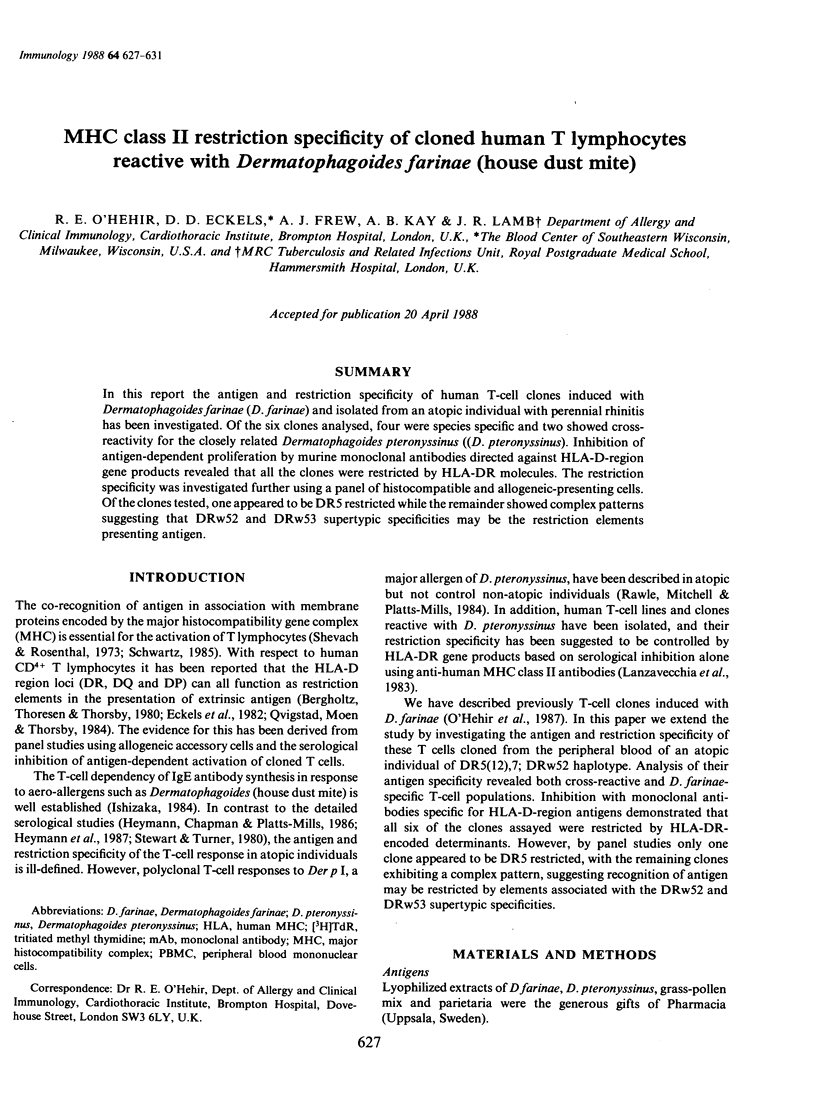
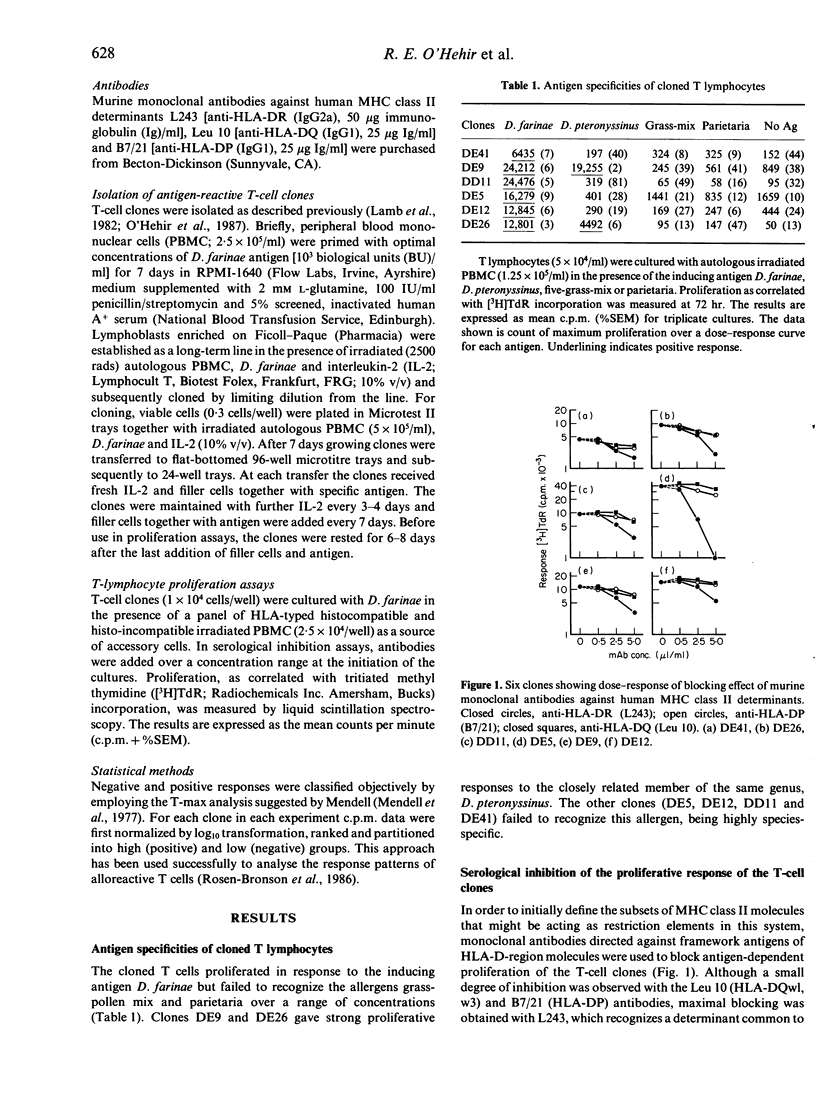
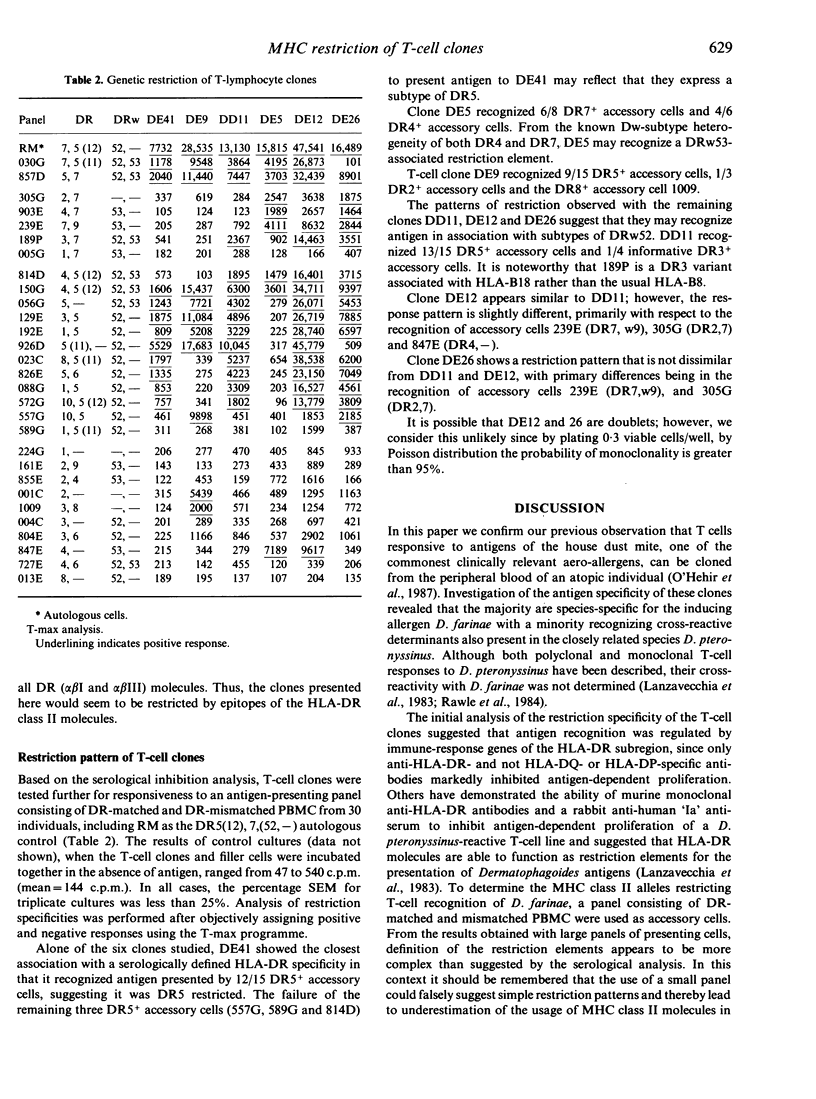
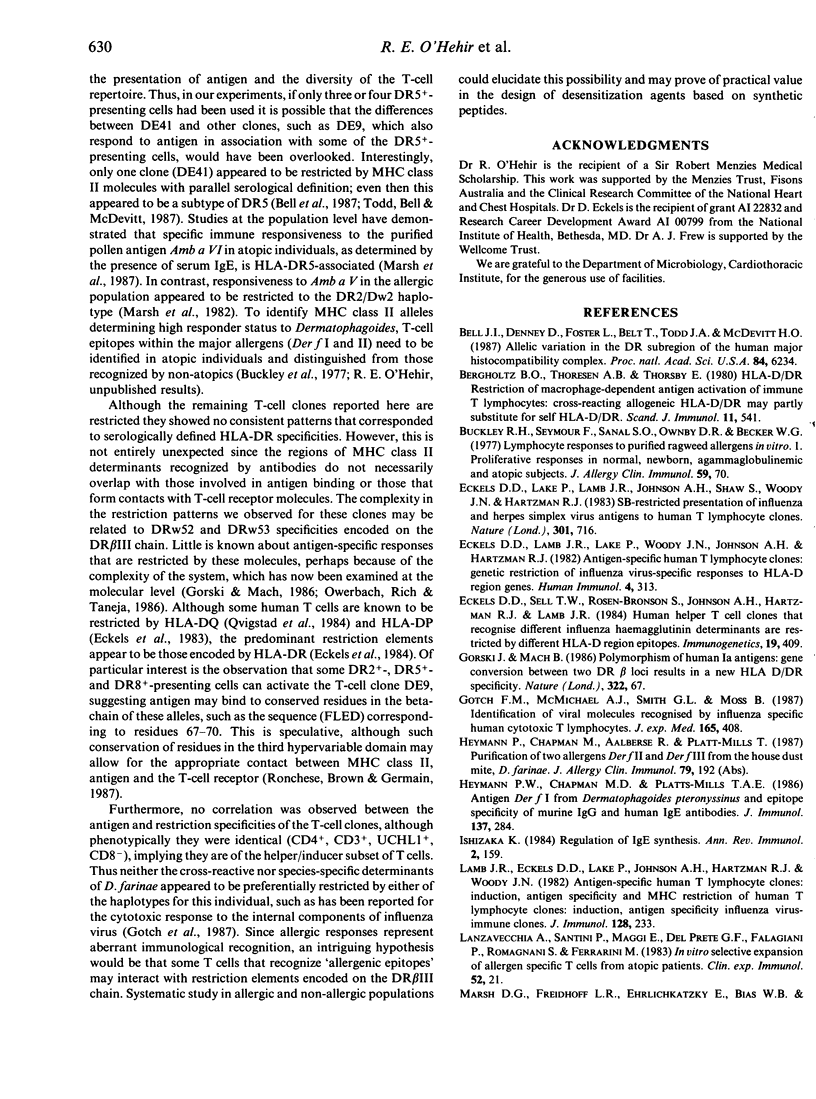
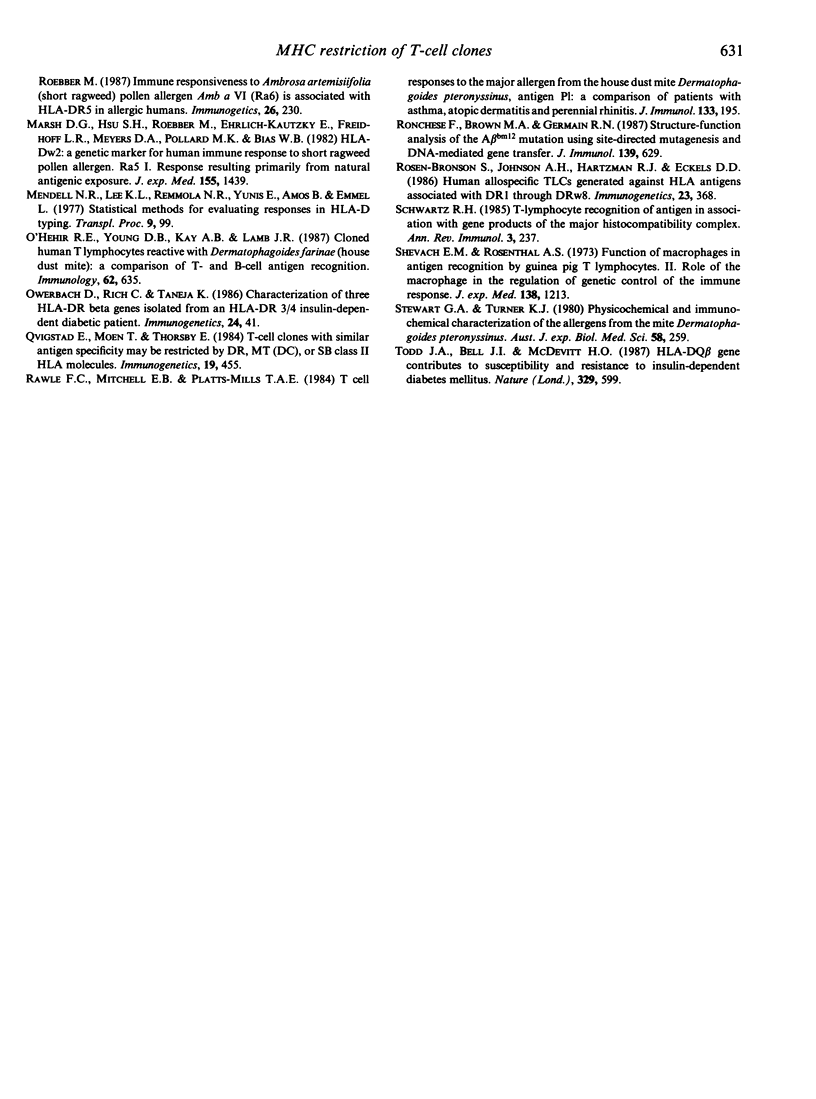
Selected References
These references are in PubMed. This may not be the complete list of references from this article.
- Bell J. I., Denney D., Jr, Foster L., Belt T., Todd J. A., McDevitt H. O. Allelic variation in the DR subregion of the human major histocompatibility complex. Proc Natl Acad Sci U S A. 1987 Sep;84(17):6234–6238. doi: 10.1073/pnas.84.17.6234. [DOI] [PMC free article] [PubMed] [Google Scholar]
- Bergholtz B. O., Thoresen A. B., Thorsby E. HLA-D/DR restriction of macrophage-dependent antigen activation of immune T lymphocytes: cross-reacting allogeneic HLA-D/DR may partly substitute for self HLA-D/DR. Scand J Immunol. 1980;11(5):541–548. doi: 10.1111/j.1365-3083.1980.tb00022.x. [DOI] [PubMed] [Google Scholar]
- Buckley R. H., Seymour F., Sanal S. O., Ownby D. R., Becker W. G. Lymphocyte responses to purified ragweed allergens in vitro. I. Proliferative responses in normal, newborn, agammaglobulinemic, and atopic subjects. J Allergy Clin Immunol. 1977 Jan;59(1):70–78. doi: 10.1016/0091-6749(77)90180-4. [DOI] [PubMed] [Google Scholar]
- Eckels D. D., Lake P., Lamb J. R., Johnson A. H., Shaw S., Woody J. N., Hartzman R. J. SB-restricted presentation of influenza and herpes simplex virus antigens to human T-lymphocyte clones. Nature. 1983 Feb 24;301(5902):716–718. doi: 10.1038/301716a0. [DOI] [PubMed] [Google Scholar]
- Eckels D. D., Lamb J. R., Lake P., Woody J. N., Johnson A. H., Hartzman R. J. Antigen-specific human T-lymphocyte clones. Genetic restriction of influenza virus-specific responses to HLA-D region genes. Hum Immunol. 1982 Jul;4(4):313–324. doi: 10.1016/0198-8859(82)90004-0. [DOI] [PubMed] [Google Scholar]
- Eckels D. D., Sell T. W., Bronson S. R., Johnson A. H., Hartzman R. J., Lamb J. R. Human helper T-cell clones that recognize different influenza hemagglutinin determinants are restricted by different HLA-D region epitopes. Immunogenetics. 1984;19(5):409–423. doi: 10.1007/BF00364644. [DOI] [PubMed] [Google Scholar]
- Gotch F., McMichael A., Smith G., Moss B. Identification of viral molecules recognized by influenza-specific human cytotoxic T lymphocytes. J Exp Med. 1987 Feb 1;165(2):408–416. doi: 10.1084/jem.165.2.408. [DOI] [PMC free article] [PubMed] [Google Scholar]
- Ishizaka K. Regulation of IgE synthesis. Annu Rev Immunol. 1984;2:159–182. doi: 10.1146/annurev.iy.02.040184.001111. [DOI] [PubMed] [Google Scholar]
- Lamb J. R., Eckels D. D., Lake P., Johnson A. H., Hartzman R. J., Woody J. N. Antigen-specific human T lymphocyte clones: induction, antigen specificity, and MHC restriction of influenza virus-immune clones. J Immunol. 1982 Jan;128(1):233–238. [PubMed] [Google Scholar]
- Lanzavecchia A., Santini P., Maggi E., Del Prete G. F., Falagiani P., Romagnani S., Ferrarini M. In vitro selective expansion of allergen specific T cells from atopic patients. Clin Exp Immunol. 1983 Apr;52(1):21–28. [PMC free article] [PubMed] [Google Scholar]
- Marsh D. G., Freidhoff L. R., Ehrlich-Kautzky E., Bias W. B., Roebber M. Immune responsiveness to Ambrosia artemisiifolia (short ragweed) pollen allergen Amb a VI (Ra6) is associated with HLA-DR5 in allergic humans. Immunogenetics. 1987;26(4-5):230–236. doi: 10.1007/BF00346517. [DOI] [PubMed] [Google Scholar]
- Marsh D. G., Hsu S. H., Roebber M., Ehrlich-Kautzky E., Freidhoff L. R., Meyers D. A., Pollard M. K., Bias W. B. HLA-Dw2: a genetic marker for human immune response to short ragweed pollen allergen Ra5. I. Response resulting primarily from natural antigenic exposure. J Exp Med. 1982 May 1;155(5):1439–1451. doi: 10.1084/jem.155.5.1439. [DOI] [PMC free article] [PubMed] [Google Scholar]
- Mendell N. R., Lee K. L., Reinsmoen N., Yunis E., Amos D. B., Emme L. Statistical methods for evaluating responses in HLA-D typing. Transplant Proc. 1977 Mar;9(1 Suppl 1):99–106. [PubMed] [Google Scholar]
- O'Hehir R. E., Young D. B., Kay A. B., Lamb J. R. Cloned human T lymphocytes reactive with Dermatophagoides farinae (house dust mite): a comparison of T- and B-cell antigen recognition. Immunology. 1987 Dec;62(4):635–640. [PMC free article] [PubMed] [Google Scholar]
- Qvigstad E., Moen T., Thorsby E. T-cell clones with similar antigen specificity may be restricted by DR, MT(DC), or SB class II HLA molecules. Immunogenetics. 1984;19(5):455–460. doi: 10.1007/BF00364648. [DOI] [PubMed] [Google Scholar]
- Rawle F. C., Mitchell E. B., Platts-Mills T. A. T cell responses to the major allergen from the house dust mite Dermatophagoides pteronyssinus, Antigen P1: comparison of patients with asthma, atopic dermatitis, and perennial rhinitis. J Immunol. 1984 Jul;133(1):195–201. [PubMed] [Google Scholar]
- Ronchese F., Brown M. A., Germain R. N. Structure-function analysis of the Abm12 beta mutation using site-directed mutagenesis and DNA-mediated gene transfer. J Immunol. 1987 Jul 15;139(2):629–638. [PubMed] [Google Scholar]
- Rosen-Bronson S., Johnson A. H., Hartzman R. J., Eckels D. D. Human allospecific TLCs generated against HLA antigens associated with DR1 through DRw8. I. Growth and specificity analysis. Immunogenetics. 1986;23(6):368–378. doi: 10.1007/BF00372669. [DOI] [PubMed] [Google Scholar]
- Schwartz R. H. T-lymphocyte recognition of antigen in association with gene products of the major histocompatibility complex. Annu Rev Immunol. 1985;3:237–261. doi: 10.1146/annurev.iy.03.040185.001321. [DOI] [PubMed] [Google Scholar]
- Shevach E. M., Rosenthal A. S. Function of macrophages in antigen recognition by guinea pig T lymphocytes. II. Role of the macrophage in the regulation of genetic control of the immune response. J Exp Med. 1973 Nov 1;138(5):1213–1229. doi: 10.1084/jem.138.5.1213. [DOI] [PMC free article] [PubMed] [Google Scholar]
- Stewart G. A., Turner K. J. Physicochemical and immunochemical characterization of the allergens from the mite Dermatophagoides pteronyssinus. Aust J Exp Biol Med Sci. 1980 Jun;58(3):259–274. doi: 10.1038/icb.1980.26. [DOI] [PubMed] [Google Scholar]
- Todd J. A., Bell J. I., McDevitt H. O. HLA-DQ beta gene contributes to susceptibility and resistance to insulin-dependent diabetes mellitus. Nature. 1987 Oct 15;329(6140):599–604. doi: 10.1038/329599a0. [DOI] [PubMed] [Google Scholar]


